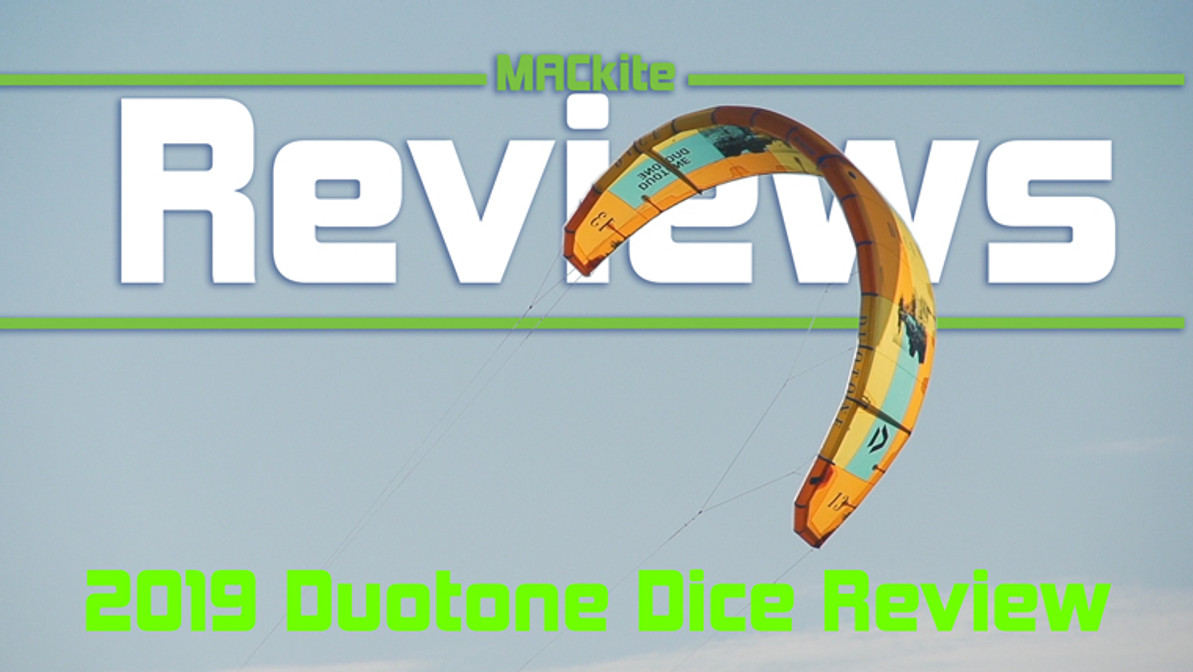2019 Duotone Dice Review
2019 Duotone Dice Review
So you’re thinking of crossing over to the Dice? I get it, explosive pop, forgiving slack, powerful loops and a kite that loves side and side off shore waves. After all, if you’re an intermediate or advanced rider it’s fun to upgrade to an advanced kite. There are some things to consider before making the leap. I’ve done quite a few videos on the topic of freestyle kites now. I’ll include a link to one of those videos in this blog so you can dive in deeper and learn more on the topic.
A little education on kite categories.
That said, I’ve been logging a lot of hours on this kite and I have some new insights to bring into the 2019 review. Let’s get into it.
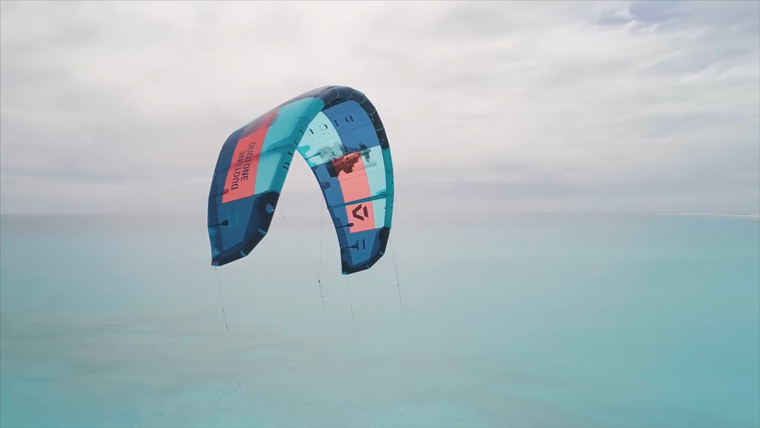
Wind Range
The wind range is an interesting point. If you pull up Duotone's wind range chart on the Dice you might notice that it’s not that different from the Rebel. You’ll lose roughly a knot on the bottom end and two knots on the top end. That said, there is more to this than meets the eye.
Dice Wind Range

Rebel Wind Range

Not a far cry right?
A stick shift feel
I’ve made this analogy in many videos but it does need to be said again. The Dice is akin to a manual transmission. It’s more fun to fly but it does take a little more work on the riders end. This applies to just about every facet of the kite. Including the wind range.
What it boils down to is advanced riders will find this chart to be pretty accurate. The Dice won’t match the low end pull that freeride kites offer. It also tends to get overpowered a little faster. Granted not by that much. Now, if you’re a new rider the gap gets wider. This is in complete relation to the riders skill level.
The Dice likes to be flown activity, meaning if you don’t know how to properly sine a kite, good luck getting upwind. Granted, knowing how to sine the kite is a pretty simple skill to learn to don’t let that scare you. It’s something you could become very proficient in as little as one to three sessions.
The mostly applies to the bottom end of the kites wind range. When you’re powered up, the Dice is going to for the most part just sit there and pull. Unlike its freeride counterparts, you’ll need to start signing much sooner and more actively. For Example in gusty or inconsistent conditions. You’ll be alternating back and forth from parking the kite to working it depending on what the wind is doing.
A couple factors are going to impact this. Chopy water for example. With most freeride kites choppy water does not impact the kite all that much. The Dice however is tuned into rider feedback. So if you’re edging though chop with an inconsistent edge the kite will respond to this feedback. You might feel varying abrupt tension in your lines. Paring this with gusty wind an inexperienced rider may have a more difficult time getting upwind.
Now, you’re probably asking yourself why the heck would I want to fly the Dice? Well, riders who are looking for an aggressive raw yet fun and responsive kite. With a bit of experience, you’ll be able to work the kite in light or gusty wind and you’ll learn how to control the kite in choppy water.
This is a kite that very much becomes an extension of you! So don’t let the reduced wind range scare you. With just a bit of practice, you’ll grow your skill set and after that, the wind range is not far off from the Rebel. A kite with arguably the largest wind range on the market.
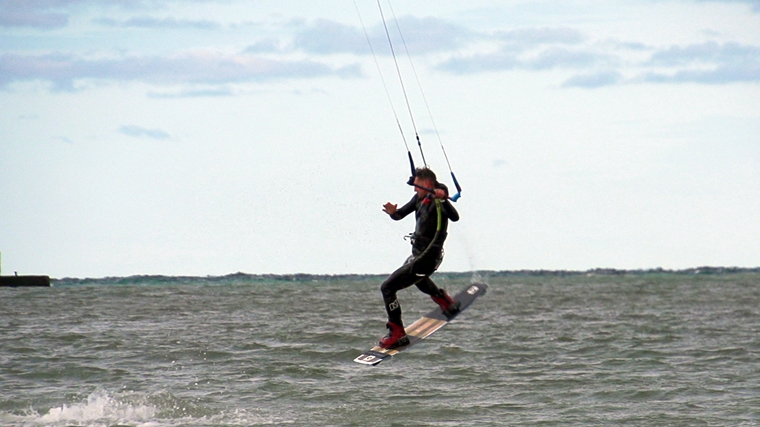
There is a lot of adjustability with the bar pressure
Bar pressure and feel.
All Duotone kites are characterized by a lighter bar feel. Recently I’ve settled on moderate as the word to describe it. That said, this is subjective. I’ve had friends who are used to freeride kites test this kite. Their initial response was where is the kite? A couple things come into play here as well.
There are three settings on the wingtip. Soft medium and hard. The soft setting is going to be quite light and fast. The hard setting is my personal preference and makes for a moderate bar pressure, more feedback from the kite and slows down the kite. Granted, it’s still pretty fast. The Standard medium setting bridges the gap.
The bar pressure conversation can be pretty subjective. If you normally ride a kite like the Switchblade, you’ll find the pressure to be very light. If you ride kite like the Liquid force NV, you’ll think it’s pretty standard.
The feel of this kite is what makes it so special. The Dice bridges the gap between the Evo and the Vegas. With the Evo being a user friendly all around kite and the Vegas being an advance unhooked freestyle kite. The Dice, over the years has become more of a firecracker as I like to say. Meaning every year, seems to take an incremental step towards the Vegas.
Expect an explosive feel and lots of slack. The first time, I tested the Dice in 2016 I was actually caught off guard. When you nail the unhooked pop, There is a sensation of free fall and you don’t have the kite pulling you through the trick. Recently I had some friends test out the Dice and they had the same experience. When it comes to sent airs, the kite has an aggressive feel that rips you off the water.
If you’re an experienced rider who keeps the kite at 11 or 1 on a sent jump, you can expect your tricks to look powered and critical. Something a lot of riders do is keep their kite above them on a sent jump. This might feel safer and loftier but it’s not going to look as stylish or feel as powerful. The Dice is meant to add power and style to your riding. It likes to pull forward in the air making everything you do look and feel more critical.
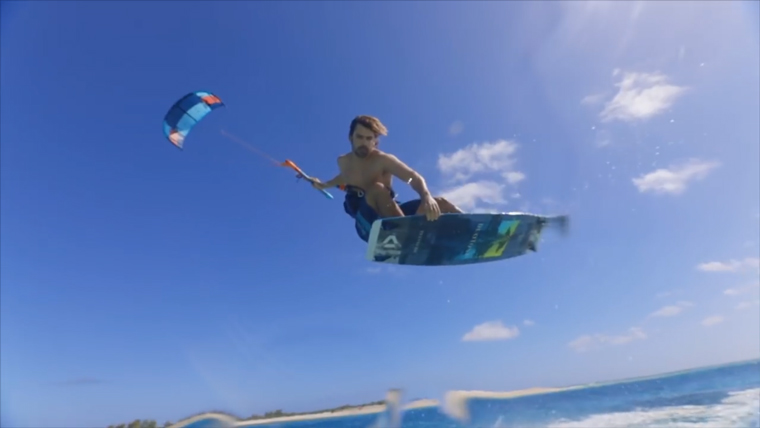
The Dice has an aggressive jump
Jumping
When it comes to Jumping the Dice is explosive and raw. The jump is not as vertical as say the Rebel. It has a little more downwind drift and less loft. Board speed and timing are important as well.
This is why intermediate or advanced riders love the Dice. As I said, the kite very much becomes an extension of the rider. Unlike freeride kites that effectively operate on autopilot.
Board speed is needed for height. The faster you come into a jump, the more height and power you can expect. The same logic applies when unhooking. Just how explosive the kite is depends on how hard you load, how fast you’re going and when you pop.
The Dice isn’t Duotones loftiest kite but it is the most explosive kite after the Vegas.
This is where personal style comes into play. Of course you can still do very large sent airs but you’ll be doing yourself a disservice if you don’t take advantage of this kites unique characteristics. For hooked in sent jumps, Make sure right after you pop that you pull on your front hand and drive the kite not just up but forward. The kite is going to rip you forward through the air laying you out just a bit. Effectively your tricks are going to look more like a snowboarder jumping off a kicker. You’ll not only be pulled up but forward. Pair this with the agressive feel of the Dice and you can really mix up your riding from smooth to powered depending on your mood.
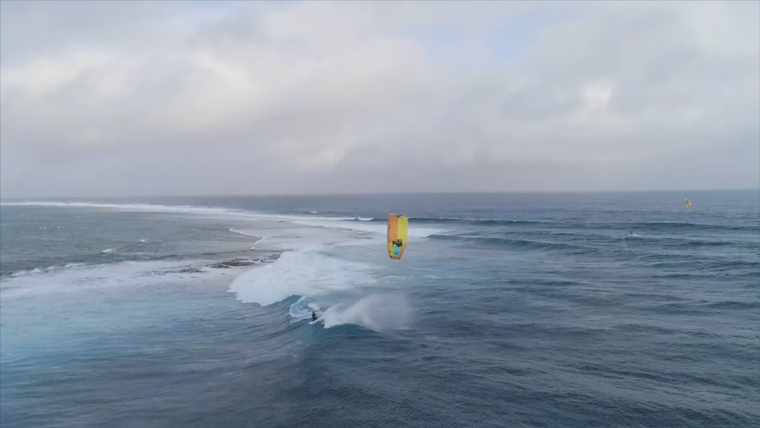
Waves
The Dice is unique in the sense that while it shines for high level freestylers, it also shines in the waves. There are some things to consider however. The Dice is fast, it loops easily and it doesn’t have massive amounts of grunt. Making it a good contender when kitesurfing. The fact that the Dice isn’t very grunty helps as it’s not a kite that will just pull you off the wave.
The speed is useful as when it comes to wave riding with an active kite, you’ll want to precede any board or body movement with the kite. The more delay in the kites response, the earlier you have to anticipate your moves. With the Dice, this makes for a very “in the moment feel” on the waves.
The Dice shines in side shore winds and offshore winds. So when it comes to side on or onshore winds, It’s not going to Drift like the Neo. That’s not to say you can’t use it in these conditions, just that you will have to actively fly the kite to avoid your lines from slacking too much.
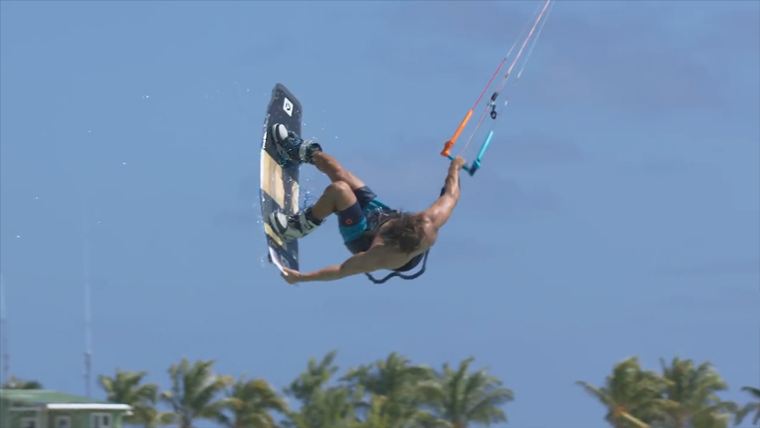
The Dice is the preferred choice for unhooked riders.
Unhooked freestyle
If your main game is progression with unhooked riding, this is where the Dice is going to shine. Most of the attributes we discussed come down to that simple point.
Most unhooked freestyle riders are looking for a handful of things from their kite. It needs to have an explosive pop, the lines should slack, the kite should deliver good feedback to the rider. This pretty much sums up the Dice. Like I said, the kite becomes an extension of the rider.
When discussing the wind range, I mentioned you have to work the kite at times. This is a big aspect in unhooked riding. You want to generate pop from board speed, not kitepower. A kite that simply rips you off the water, will often pull like a truck through the trick. On kites like that, It can get pretty tiring pulling the bar back to your hip and rotating around the bar can be a bit more changing with all the forward pull.
The Dice pretty much eliminates this problem. Not only is it a kite that uses boardspeed for pop but I mentioned the feeling of weightlessness earlier as well. Imagine how much easier Freestyle tricks are when you have complete freedom of movement. You still have to pull the bar close to you hip, but it takes less strength from the rider. That means you’ll expend less energy doing pull ups and more energy progressing.
Something else I’ve come to appreciate about the Dice in this aspect is that even while underpowered, you can still get more pop than you would expect from this kite. You need to build up some speed riding downwind but when you load underpowered, the kite still has that slingshot effect.
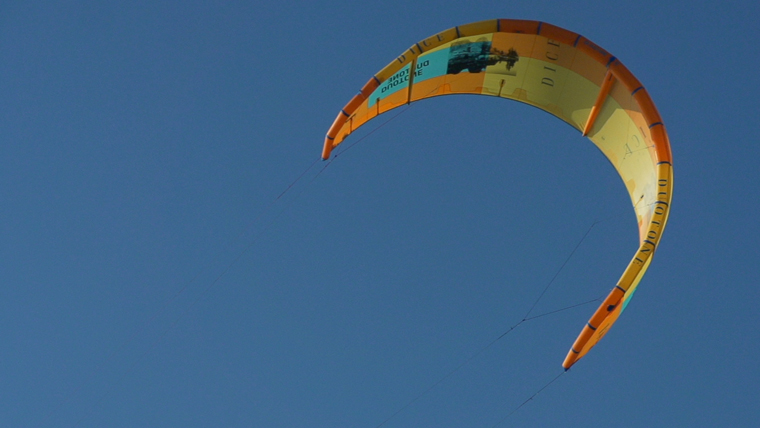
Stability
This is one of those areas where an intermediate rider who’s had a couple sessions on any freestyle crossover kite would not be impacted. A completely new rider or a rider who does not understand freestyle kites is going to have a small learning curve.
All the traits that make the Dice excel in unhooked riding or more stylish aggressive hooked in freestyle. All the traits that create that raw connection between the rider and the kite well, this comes into consideration on this point.
Now, the Dice is stable, I’ve done plenty of videos on this. That said, having done a couple videos I wanted to dive deeper with new insights. ."It handles gusty wind quite well. However, as I had mentioned earlier, riding in choppy water and gusty wind you’ll have to do a bit more work on your end to keep the kite in complete control". So if the water is choppy, you need to make sure you keep a solid connection to the water. If you have an inconsistent edge, you’ll notice small but abrupt changes in the line tension. This doesn't affect much except when paired with gusty wind. In these instances, the kite will remain stable but you won't have a clean consistent pull.
To give perspective, I have let some locals who never have used a freestlye kite demo my Dice in some choppy gusty conditions. So long as they were aware of the kites characteristics and how to handle it, they loved it! If you’re unaware and you don’t know how to respond, you might get the wrong impression. It doesn't take much work at all to learn how to fly a freestlyle kite and it’s pretty hard to beat that raw, “connected to your kite” feeling. Let’s face it, we kite because we love to progress. There are some small skills that come along with all freestyle kites that make them that much more fun.
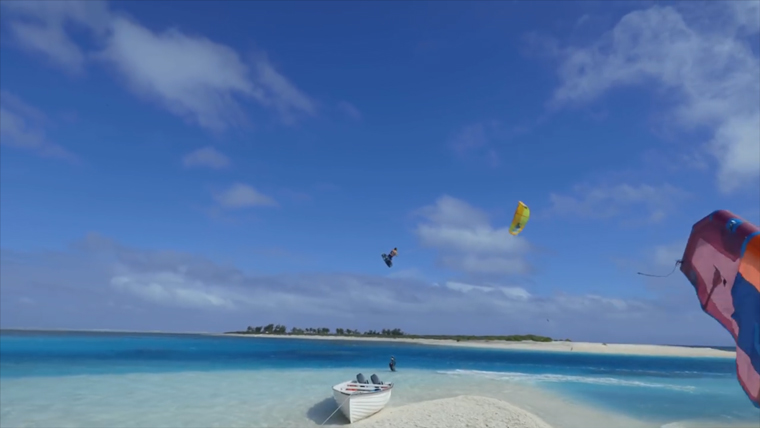
Kiteloops.
If kiteloops are your thing, the Dice is probably the kite you want to be on. The kite is powerful and fast. No other kite in Duotones line up will compare except the Vegas. If you’re looking for a raw, powerful kite to incorporate powerful loop based tricks into your riding or you’re a mega loop type of rider, the Dice was designed with you in mind. It has a grunty loop and the speed makes its quite easy to catch yourself.
Summary
For a certain rider, The Dice is arguably the most fun kite to fly in Duotones lineup.
A rider who is looking for a kite that requires a bit of rider feedback, yet responds with the perfect blend of characteristics for aggressive stylish freestylers, unhooked riders, advanced wave riders and of course mega loopers.
It’s a kite that is still user friendly, but does have a very small learning curve. Simply because this kite becomes an extension of you. Unlike freeride kites that operate on autopilot, the Dice is more involved and exceptionally fun to fly. A new rider could learn on one yet it would take a bit longer. An intermediate or advanced rider looking to step up their game or change their riding style is going to love the Dice.
Like all my videos, I welcome your feedback. This is always an open forum so! If you ride the Neo, let us know what you think. Leave a comment for others researching this kite and help them out. \
If you found this video helpful please give it a thumbs up and hit that subscribe button. If you’ve already subscribed and you like the content we’re dropping regularly here go ahead and hit the bell icon. That way you’ll actually get an alert whenever we release a new video.
 Ryan (Rygo) Goloversic
Ryan (Rygo) Goloversic
Just a dude from a kite shop testing all the gear one session at a time.
Many people dream of quitting their job, traveling the world and pursuing their passions. Rygo is one of those people who pulled the trigger. About eight years into a postal career, he decided to change everything and travel as a freelance videographer & writer. This took him from coast to coast and a variety of countries. Nowadays you can catch him on the phones, doing lessons, or working on videos. Of course, he still makes a point to travel as often as possible. His mission is to help people and share the stoke with his customers and students alike. Get out there and kiteboard.
Producer of: Ride with Blake I Sessions I Versus I Destinations I Foil Fridays
Recent Posts
-
North Navigator Pro Quick Release | How to Swap Yours Out With Ease
What You Need Before starting the replacement process, ensure you have all the necessary t …18th Apr 2024 -
Foil Drive | Essential Tips to Supercharge Your First Session
The Foil Drive makes your foiling life easier. You'll get up easier and catch more waves, …17th Apr 2024 -
2024 Duotone Slick Wing Review | What's New in This Year's Model?
The Duotone Slick has been a favorite of many for several years. Pros love it for its speed, …15th Apr 2024

